Microeconomics Homework: Analyzing Market Structures and Policies
VerifiedAdded on 2021/11/07
|11
|1606
|52
Homework Assignment
AI Summary
This microeconomics assignment addresses several core concepts within the field. It begins by defining and analyzing price ceilings and price floors, exploring their impacts on market equilibrium and consumer/producer surplus, and illustrating the concept of non-binding price ceilings. The assignment then delves into the concept of deadweight loss, explaining its causes and implications within the context of government interventions. Furthermore, it examines the incidence of tax, particularly focusing on how the burden of indirect taxes is shared between buyers and sellers based on elasticity of supply and demand. The assignment also considers the impact of taxes on substitute goods, using the example of beer and liquor. Finally, it explores a firm's cost function and profit maximization, determining the optimal output level for a given market price. The assignment incorporates figures and diagrams to illustrate key economic principles and provides references to relevant literature.
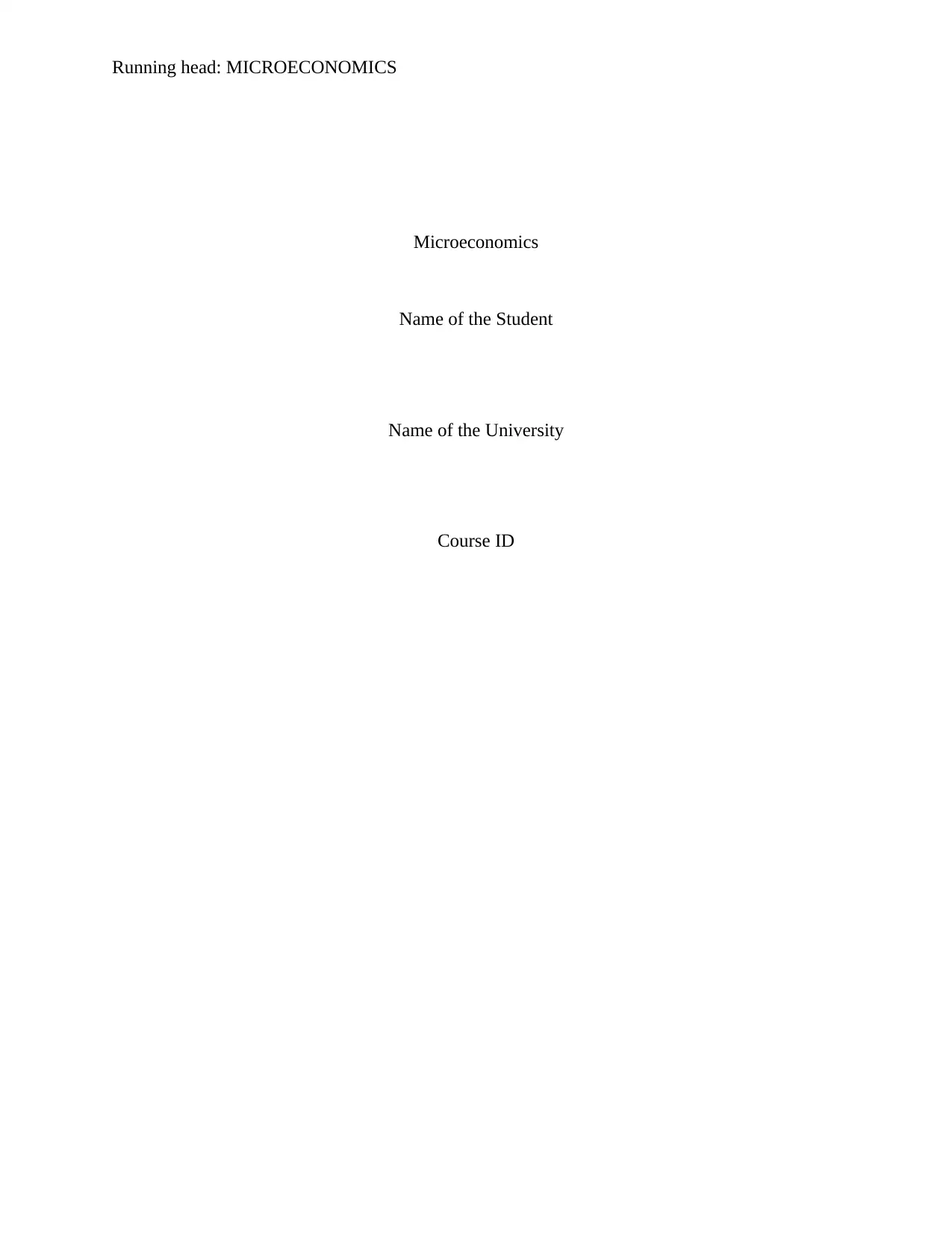
Running head: MICROECONOMICS
Microeconomics
Name of the Student
Name of the University
Course ID
Microeconomics
Name of the Student
Name of the University
Course ID
Paraphrase This Document
Need a fresh take? Get an instant paraphrase of this document with our AI Paraphraser
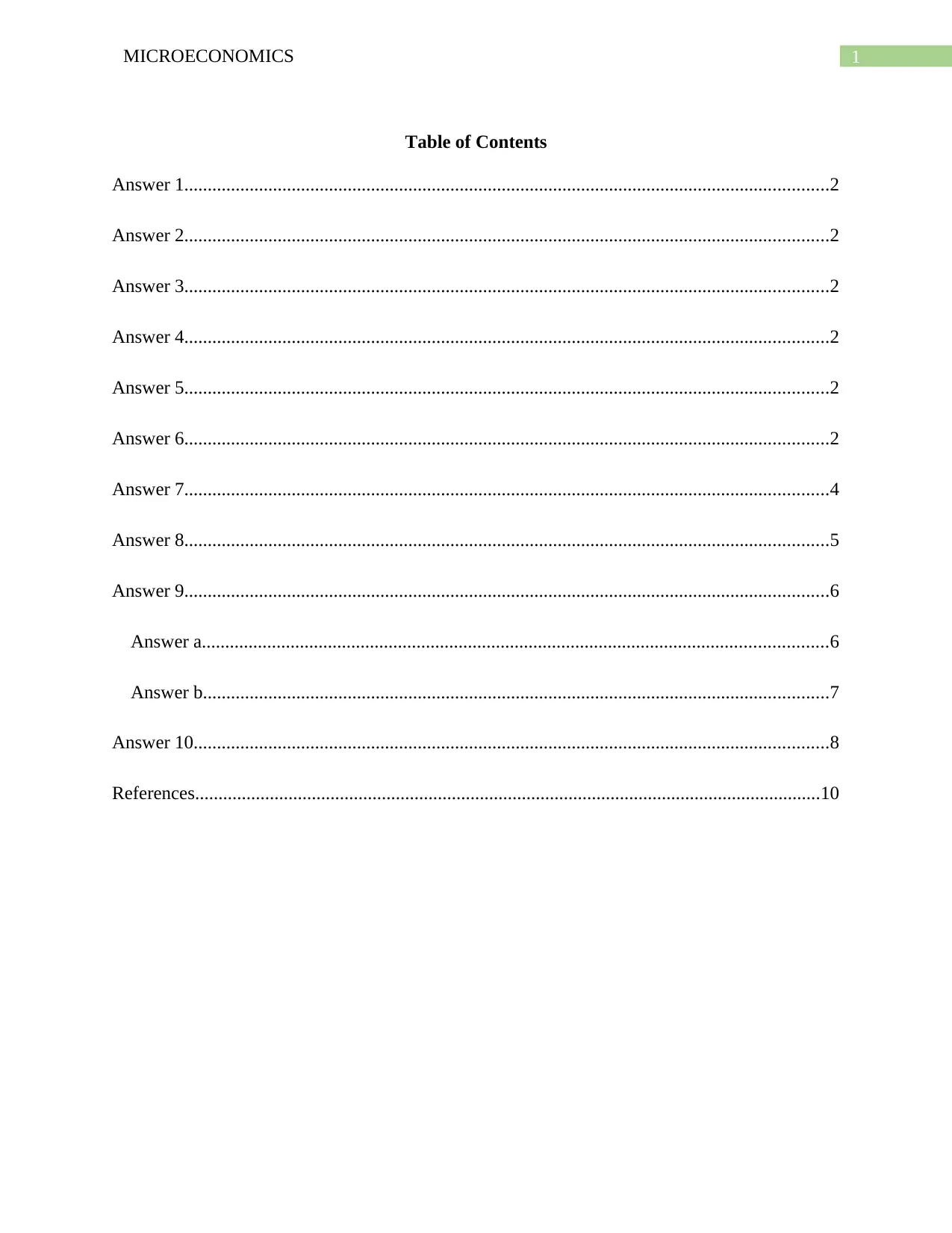
1MICROECONOMICS
Table of Contents
Answer 1..........................................................................................................................................2
Answer 2..........................................................................................................................................2
Answer 3..........................................................................................................................................2
Answer 4..........................................................................................................................................2
Answer 5..........................................................................................................................................2
Answer 6..........................................................................................................................................2
Answer 7..........................................................................................................................................4
Answer 8..........................................................................................................................................5
Answer 9..........................................................................................................................................6
Answer a......................................................................................................................................6
Answer b......................................................................................................................................7
Answer 10........................................................................................................................................8
References......................................................................................................................................10
Table of Contents
Answer 1..........................................................................................................................................2
Answer 2..........................................................................................................................................2
Answer 3..........................................................................................................................................2
Answer 4..........................................................................................................................................2
Answer 5..........................................................................................................................................2
Answer 6..........................................................................................................................................2
Answer 7..........................................................................................................................................4
Answer 8..........................................................................................................................................5
Answer 9..........................................................................................................................................6
Answer a......................................................................................................................................6
Answer b......................................................................................................................................7
Answer 10........................................................................................................................................8
References......................................................................................................................................10
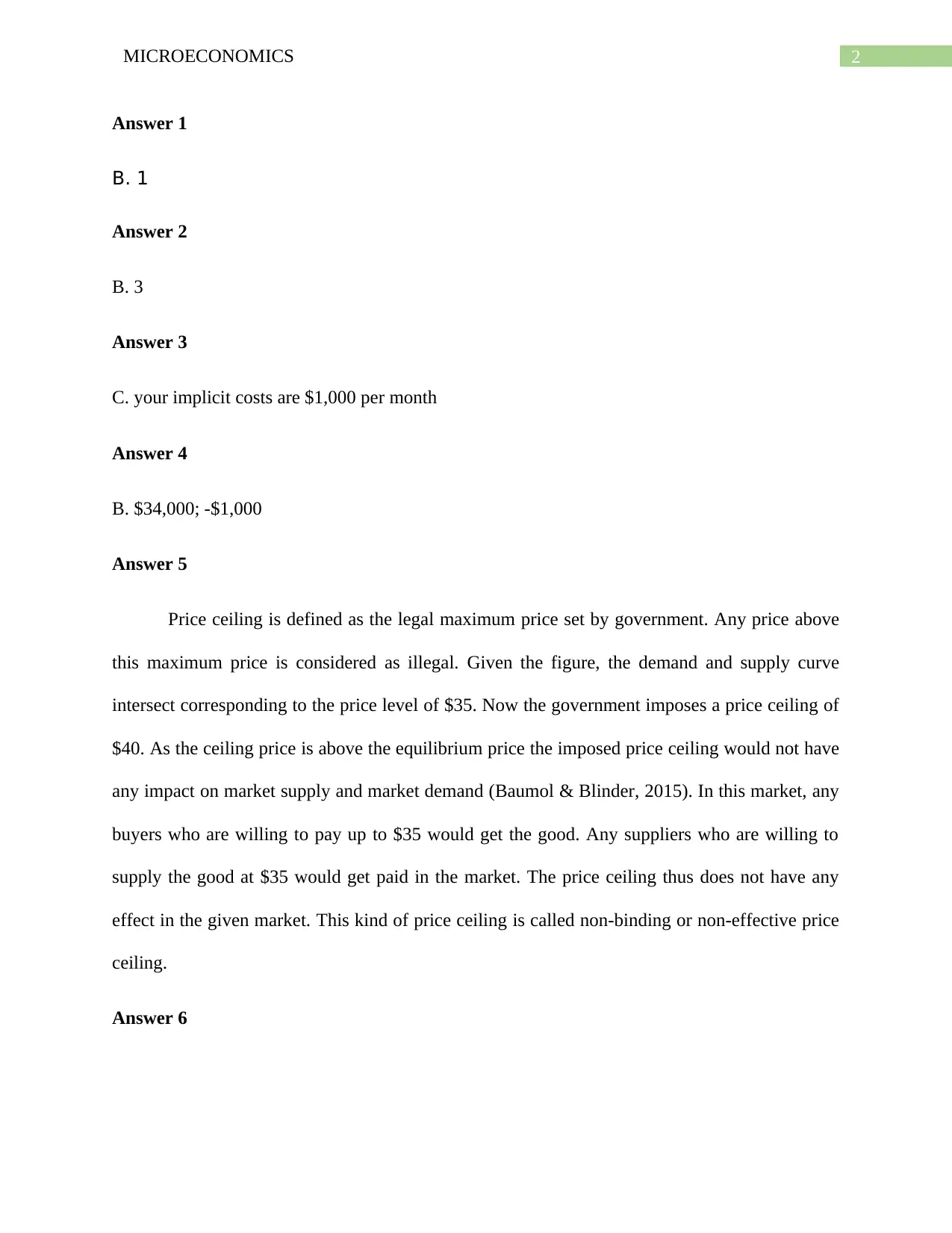
2MICROECONOMICS
Answer 1
B. 1
Answer 2
B. 3
Answer 3
C. your implicit costs are $1,000 per month
Answer 4
B. $34,000; -$1,000
Answer 5
Price ceiling is defined as the legal maximum price set by government. Any price above
this maximum price is considered as illegal. Given the figure, the demand and supply curve
intersect corresponding to the price level of $35. Now the government imposes a price ceiling of
$40. As the ceiling price is above the equilibrium price the imposed price ceiling would not have
any impact on market supply and market demand (Baumol & Blinder, 2015). In this market, any
buyers who are willing to pay up to $35 would get the good. Any suppliers who are willing to
supply the good at $35 would get paid in the market. The price ceiling thus does not have any
effect in the given market. This kind of price ceiling is called non-binding or non-effective price
ceiling.
Answer 6
Answer 1
B. 1
Answer 2
B. 3
Answer 3
C. your implicit costs are $1,000 per month
Answer 4
B. $34,000; -$1,000
Answer 5
Price ceiling is defined as the legal maximum price set by government. Any price above
this maximum price is considered as illegal. Given the figure, the demand and supply curve
intersect corresponding to the price level of $35. Now the government imposes a price ceiling of
$40. As the ceiling price is above the equilibrium price the imposed price ceiling would not have
any impact on market supply and market demand (Baumol & Blinder, 2015). In this market, any
buyers who are willing to pay up to $35 would get the good. Any suppliers who are willing to
supply the good at $35 would get paid in the market. The price ceiling thus does not have any
effect in the given market. This kind of price ceiling is called non-binding or non-effective price
ceiling.
Answer 6
⊘ This is a preview!⊘
Do you want full access?
Subscribe today to unlock all pages.

Trusted by 1+ million students worldwide
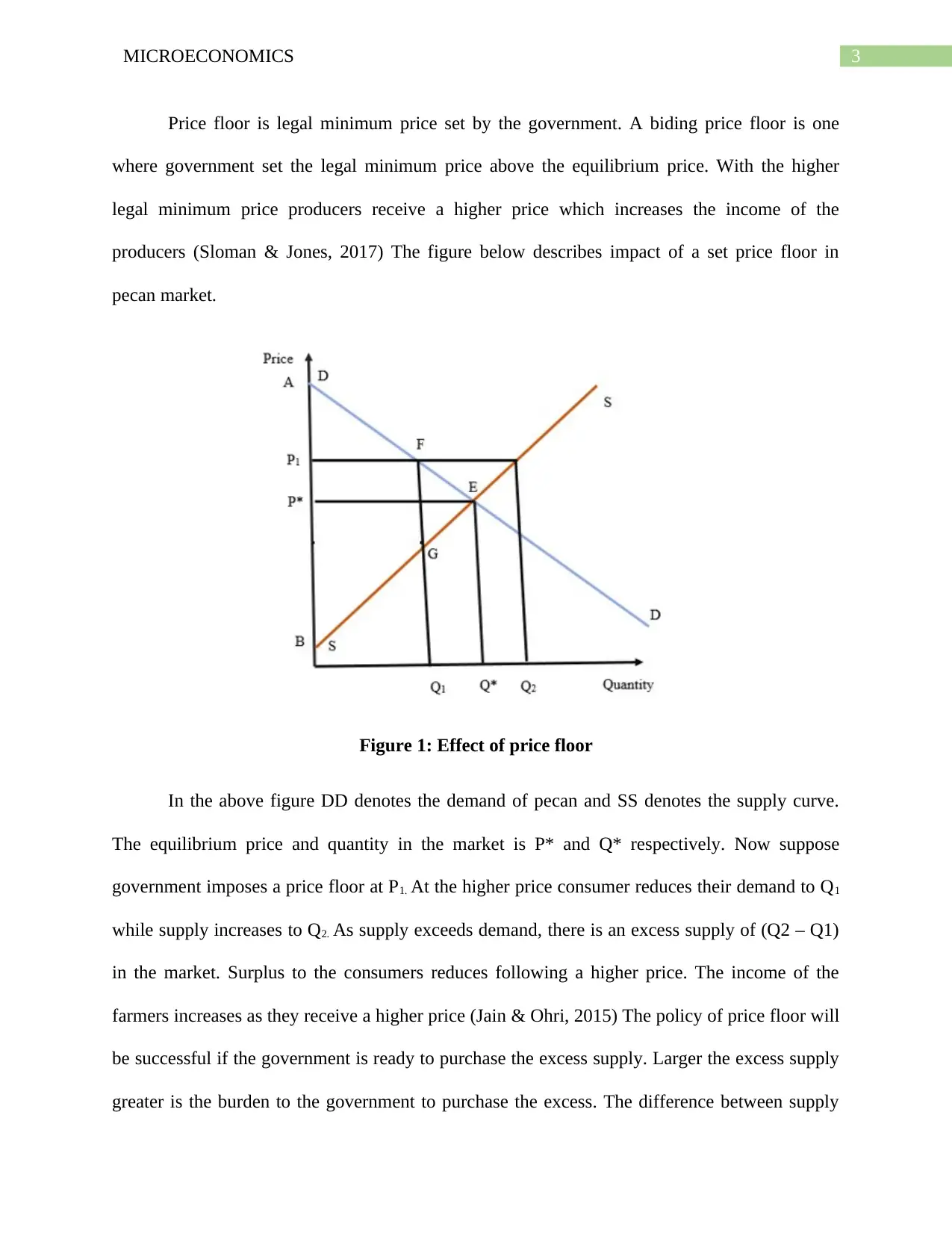
3MICROECONOMICS
Price floor is legal minimum price set by the government. A biding price floor is one
where government set the legal minimum price above the equilibrium price. With the higher
legal minimum price producers receive a higher price which increases the income of the
producers (Sloman & Jones, 2017) The figure below describes impact of a set price floor in
pecan market.
Figure 1: Effect of price floor
In the above figure DD denotes the demand of pecan and SS denotes the supply curve.
The equilibrium price and quantity in the market is P* and Q* respectively. Now suppose
government imposes a price floor at P1. At the higher price consumer reduces their demand to Q1
while supply increases to Q2. As supply exceeds demand, there is an excess supply of (Q2 – Q1)
in the market. Surplus to the consumers reduces following a higher price. The income of the
farmers increases as they receive a higher price (Jain & Ohri, 2015) The policy of price floor will
be successful if the government is ready to purchase the excess supply. Larger the excess supply
greater is the burden to the government to purchase the excess. The difference between supply
Price floor is legal minimum price set by the government. A biding price floor is one
where government set the legal minimum price above the equilibrium price. With the higher
legal minimum price producers receive a higher price which increases the income of the
producers (Sloman & Jones, 2017) The figure below describes impact of a set price floor in
pecan market.
Figure 1: Effect of price floor
In the above figure DD denotes the demand of pecan and SS denotes the supply curve.
The equilibrium price and quantity in the market is P* and Q* respectively. Now suppose
government imposes a price floor at P1. At the higher price consumer reduces their demand to Q1
while supply increases to Q2. As supply exceeds demand, there is an excess supply of (Q2 – Q1)
in the market. Surplus to the consumers reduces following a higher price. The income of the
farmers increases as they receive a higher price (Jain & Ohri, 2015) The policy of price floor will
be successful if the government is ready to purchase the excess supply. Larger the excess supply
greater is the burden to the government to purchase the excess. The difference between supply
Paraphrase This Document
Need a fresh take? Get an instant paraphrase of this document with our AI Paraphraser
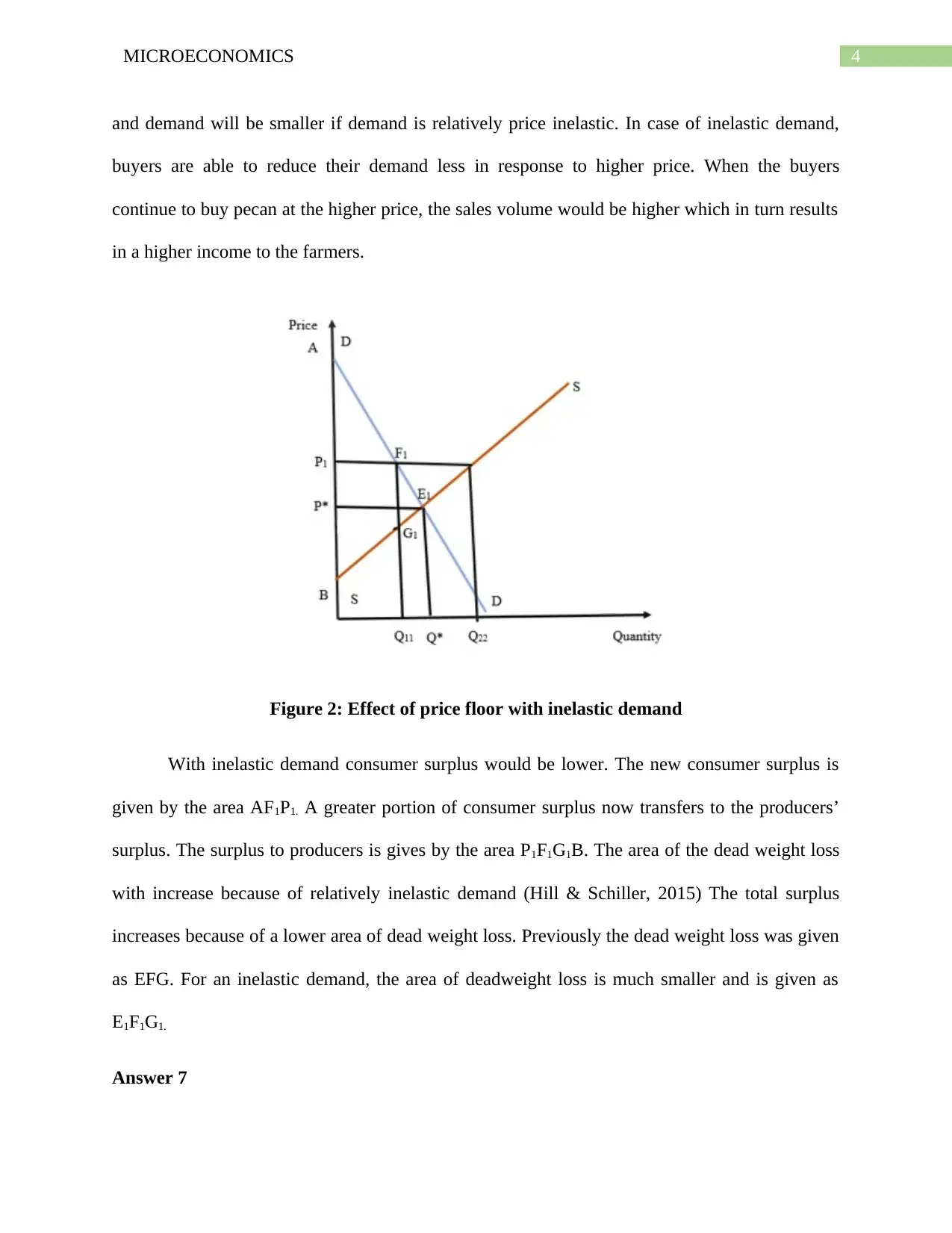
4MICROECONOMICS
and demand will be smaller if demand is relatively price inelastic. In case of inelastic demand,
buyers are able to reduce their demand less in response to higher price. When the buyers
continue to buy pecan at the higher price, the sales volume would be higher which in turn results
in a higher income to the farmers.
Figure 2: Effect of price floor with inelastic demand
With inelastic demand consumer surplus would be lower. The new consumer surplus is
given by the area AF1P1. A greater portion of consumer surplus now transfers to the producers’
surplus. The surplus to producers is gives by the area P1F1G1B. The area of the dead weight loss
with increase because of relatively inelastic demand (Hill & Schiller, 2015) The total surplus
increases because of a lower area of dead weight loss. Previously the dead weight loss was given
as EFG. For an inelastic demand, the area of deadweight loss is much smaller and is given as
E1F1G1.
Answer 7
and demand will be smaller if demand is relatively price inelastic. In case of inelastic demand,
buyers are able to reduce their demand less in response to higher price. When the buyers
continue to buy pecan at the higher price, the sales volume would be higher which in turn results
in a higher income to the farmers.
Figure 2: Effect of price floor with inelastic demand
With inelastic demand consumer surplus would be lower. The new consumer surplus is
given by the area AF1P1. A greater portion of consumer surplus now transfers to the producers’
surplus. The surplus to producers is gives by the area P1F1G1B. The area of the dead weight loss
with increase because of relatively inelastic demand (Hill & Schiller, 2015) The total surplus
increases because of a lower area of dead weight loss. Previously the dead weight loss was given
as EFG. For an inelastic demand, the area of deadweight loss is much smaller and is given as
E1F1G1.
Answer 7
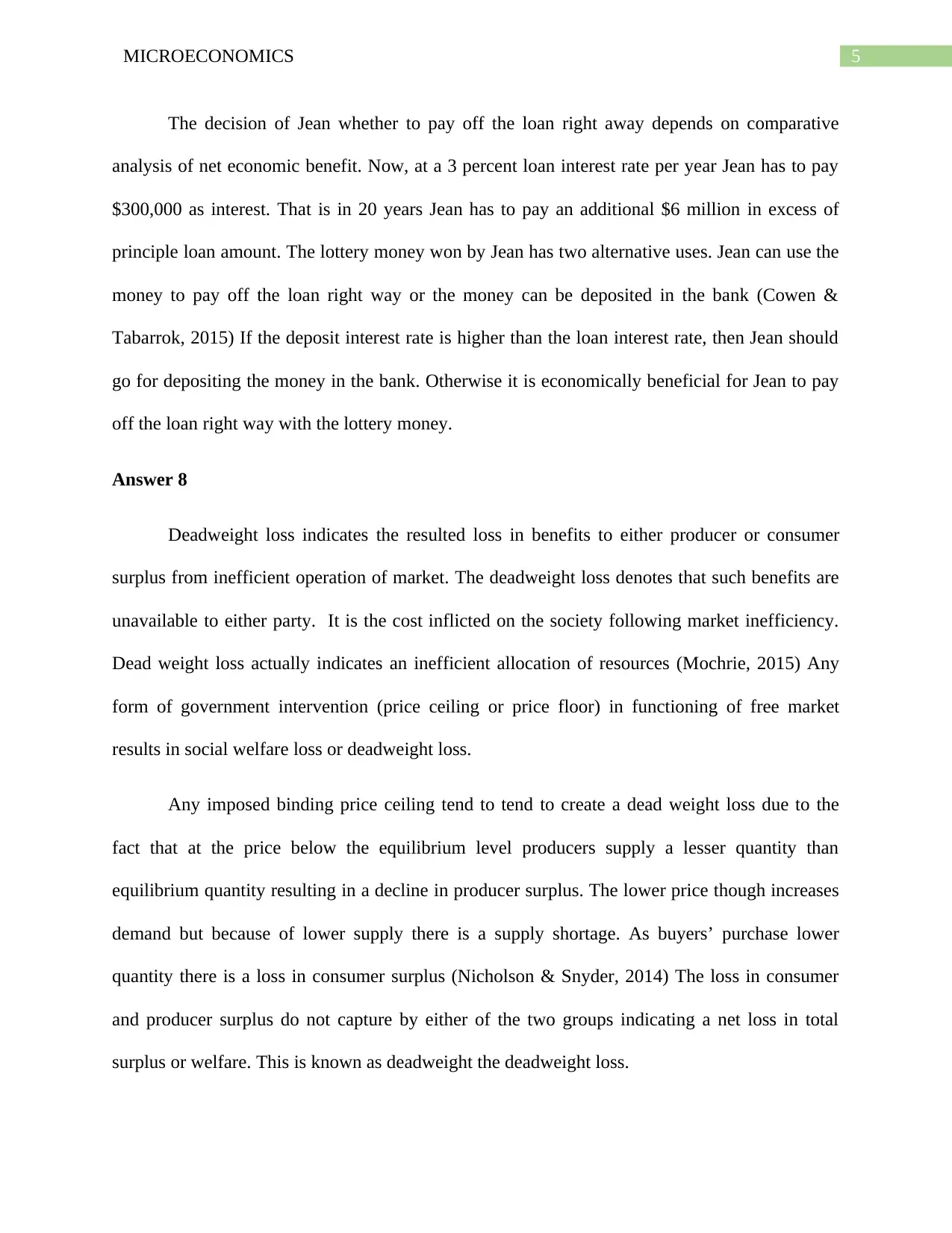
5MICROECONOMICS
The decision of Jean whether to pay off the loan right away depends on comparative
analysis of net economic benefit. Now, at a 3 percent loan interest rate per year Jean has to pay
$300,000 as interest. That is in 20 years Jean has to pay an additional $6 million in excess of
principle loan amount. The lottery money won by Jean has two alternative uses. Jean can use the
money to pay off the loan right way or the money can be deposited in the bank (Cowen &
Tabarrok, 2015) If the deposit interest rate is higher than the loan interest rate, then Jean should
go for depositing the money in the bank. Otherwise it is economically beneficial for Jean to pay
off the loan right way with the lottery money.
Answer 8
Deadweight loss indicates the resulted loss in benefits to either producer or consumer
surplus from inefficient operation of market. The deadweight loss denotes that such benefits are
unavailable to either party. It is the cost inflicted on the society following market inefficiency.
Dead weight loss actually indicates an inefficient allocation of resources (Mochrie, 2015) Any
form of government intervention (price ceiling or price floor) in functioning of free market
results in social welfare loss or deadweight loss.
Any imposed binding price ceiling tend to tend to create a dead weight loss due to the
fact that at the price below the equilibrium level producers supply a lesser quantity than
equilibrium quantity resulting in a decline in producer surplus. The lower price though increases
demand but because of lower supply there is a supply shortage. As buyers’ purchase lower
quantity there is a loss in consumer surplus (Nicholson & Snyder, 2014) The loss in consumer
and producer surplus do not capture by either of the two groups indicating a net loss in total
surplus or welfare. This is known as deadweight the deadweight loss.
The decision of Jean whether to pay off the loan right away depends on comparative
analysis of net economic benefit. Now, at a 3 percent loan interest rate per year Jean has to pay
$300,000 as interest. That is in 20 years Jean has to pay an additional $6 million in excess of
principle loan amount. The lottery money won by Jean has two alternative uses. Jean can use the
money to pay off the loan right way or the money can be deposited in the bank (Cowen &
Tabarrok, 2015) If the deposit interest rate is higher than the loan interest rate, then Jean should
go for depositing the money in the bank. Otherwise it is economically beneficial for Jean to pay
off the loan right way with the lottery money.
Answer 8
Deadweight loss indicates the resulted loss in benefits to either producer or consumer
surplus from inefficient operation of market. The deadweight loss denotes that such benefits are
unavailable to either party. It is the cost inflicted on the society following market inefficiency.
Dead weight loss actually indicates an inefficient allocation of resources (Mochrie, 2015) Any
form of government intervention (price ceiling or price floor) in functioning of free market
results in social welfare loss or deadweight loss.
Any imposed binding price ceiling tend to tend to create a dead weight loss due to the
fact that at the price below the equilibrium level producers supply a lesser quantity than
equilibrium quantity resulting in a decline in producer surplus. The lower price though increases
demand but because of lower supply there is a supply shortage. As buyers’ purchase lower
quantity there is a loss in consumer surplus (Nicholson & Snyder, 2014) The loss in consumer
and producer surplus do not capture by either of the two groups indicating a net loss in total
surplus or welfare. This is known as deadweight the deadweight loss.
⊘ This is a preview!⊘
Do you want full access?
Subscribe today to unlock all pages.

Trusted by 1+ million students worldwide
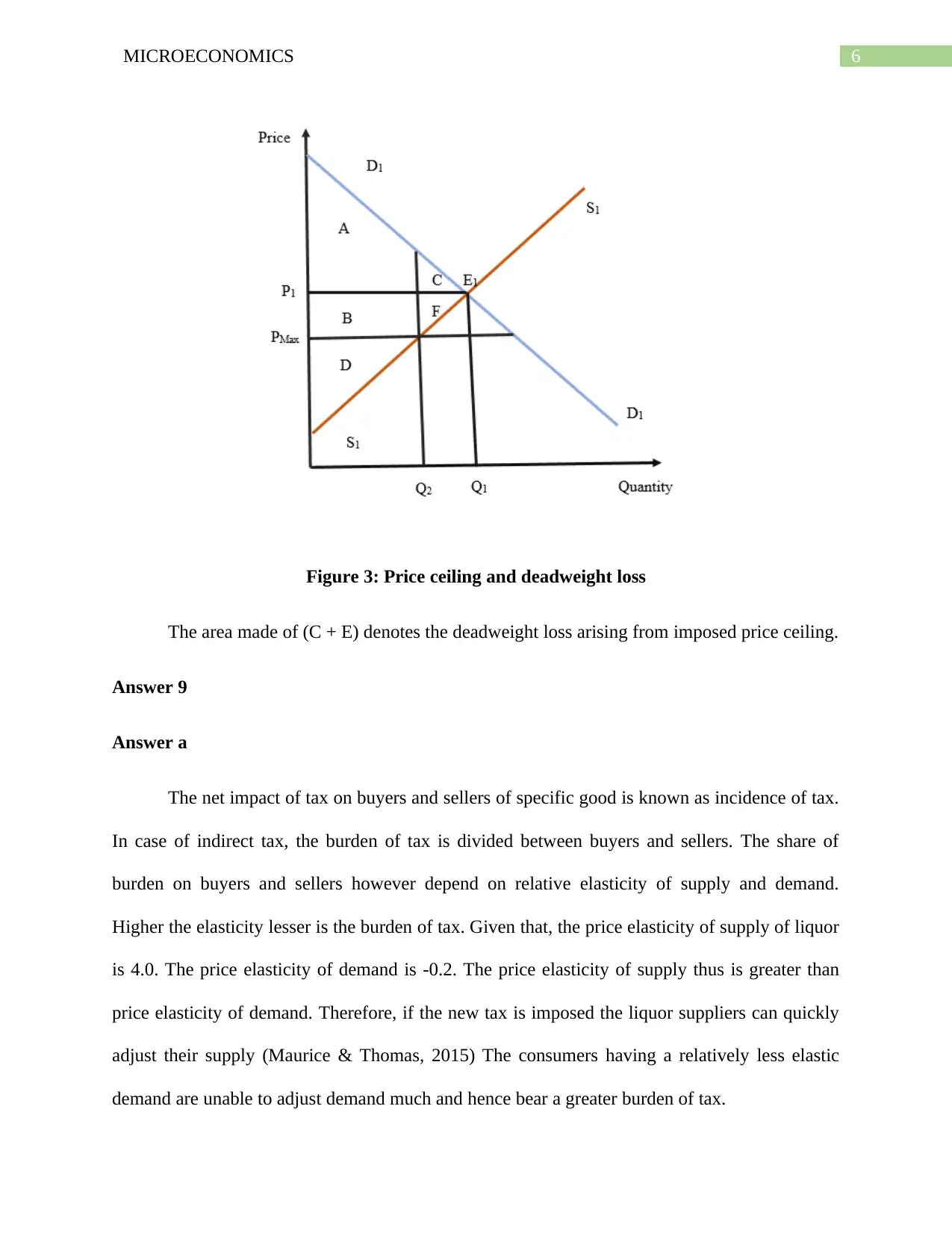
6MICROECONOMICS
Figure 3: Price ceiling and deadweight loss
The area made of (C + E) denotes the deadweight loss arising from imposed price ceiling.
Answer 9
Answer a
The net impact of tax on buyers and sellers of specific good is known as incidence of tax.
In case of indirect tax, the burden of tax is divided between buyers and sellers. The share of
burden on buyers and sellers however depend on relative elasticity of supply and demand.
Higher the elasticity lesser is the burden of tax. Given that, the price elasticity of supply of liquor
is 4.0. The price elasticity of demand is -0.2. The price elasticity of supply thus is greater than
price elasticity of demand. Therefore, if the new tax is imposed the liquor suppliers can quickly
adjust their supply (Maurice & Thomas, 2015) The consumers having a relatively less elastic
demand are unable to adjust demand much and hence bear a greater burden of tax.
Figure 3: Price ceiling and deadweight loss
The area made of (C + E) denotes the deadweight loss arising from imposed price ceiling.
Answer 9
Answer a
The net impact of tax on buyers and sellers of specific good is known as incidence of tax.
In case of indirect tax, the burden of tax is divided between buyers and sellers. The share of
burden on buyers and sellers however depend on relative elasticity of supply and demand.
Higher the elasticity lesser is the burden of tax. Given that, the price elasticity of supply of liquor
is 4.0. The price elasticity of demand is -0.2. The price elasticity of supply thus is greater than
price elasticity of demand. Therefore, if the new tax is imposed the liquor suppliers can quickly
adjust their supply (Maurice & Thomas, 2015) The consumers having a relatively less elastic
demand are unable to adjust demand much and hence bear a greater burden of tax.
Paraphrase This Document
Need a fresh take? Get an instant paraphrase of this document with our AI Paraphraser
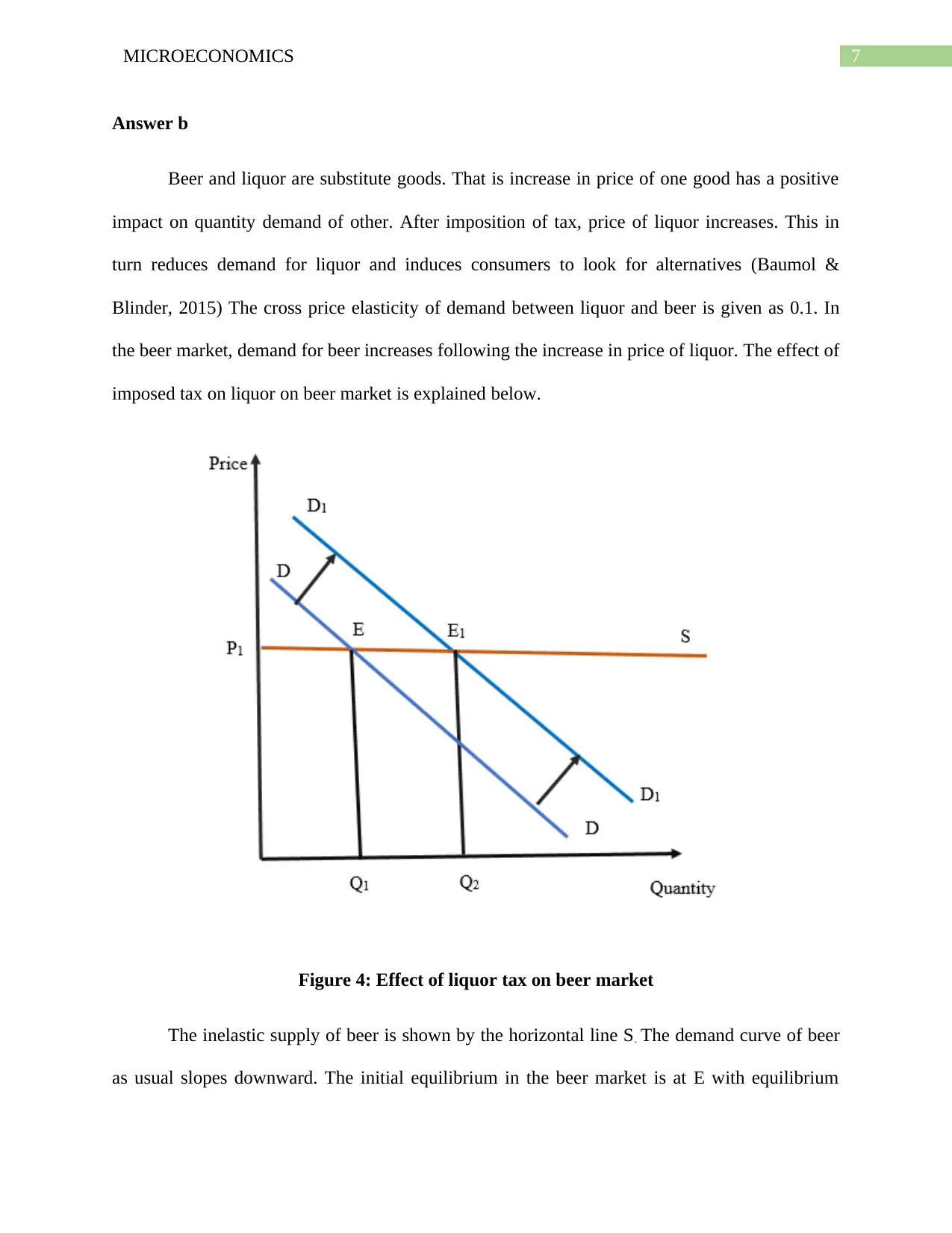
7MICROECONOMICS
Answer b
Beer and liquor are substitute goods. That is increase in price of one good has a positive
impact on quantity demand of other. After imposition of tax, price of liquor increases. This in
turn reduces demand for liquor and induces consumers to look for alternatives (Baumol &
Blinder, 2015) The cross price elasticity of demand between liquor and beer is given as 0.1. In
the beer market, demand for beer increases following the increase in price of liquor. The effect of
imposed tax on liquor on beer market is explained below.
Figure 4: Effect of liquor tax on beer market
The inelastic supply of beer is shown by the horizontal line S. The demand curve of beer
as usual slopes downward. The initial equilibrium in the beer market is at E with equilibrium
Answer b
Beer and liquor are substitute goods. That is increase in price of one good has a positive
impact on quantity demand of other. After imposition of tax, price of liquor increases. This in
turn reduces demand for liquor and induces consumers to look for alternatives (Baumol &
Blinder, 2015) The cross price elasticity of demand between liquor and beer is given as 0.1. In
the beer market, demand for beer increases following the increase in price of liquor. The effect of
imposed tax on liquor on beer market is explained below.
Figure 4: Effect of liquor tax on beer market
The inelastic supply of beer is shown by the horizontal line S. The demand curve of beer
as usual slopes downward. The initial equilibrium in the beer market is at E with equilibrium
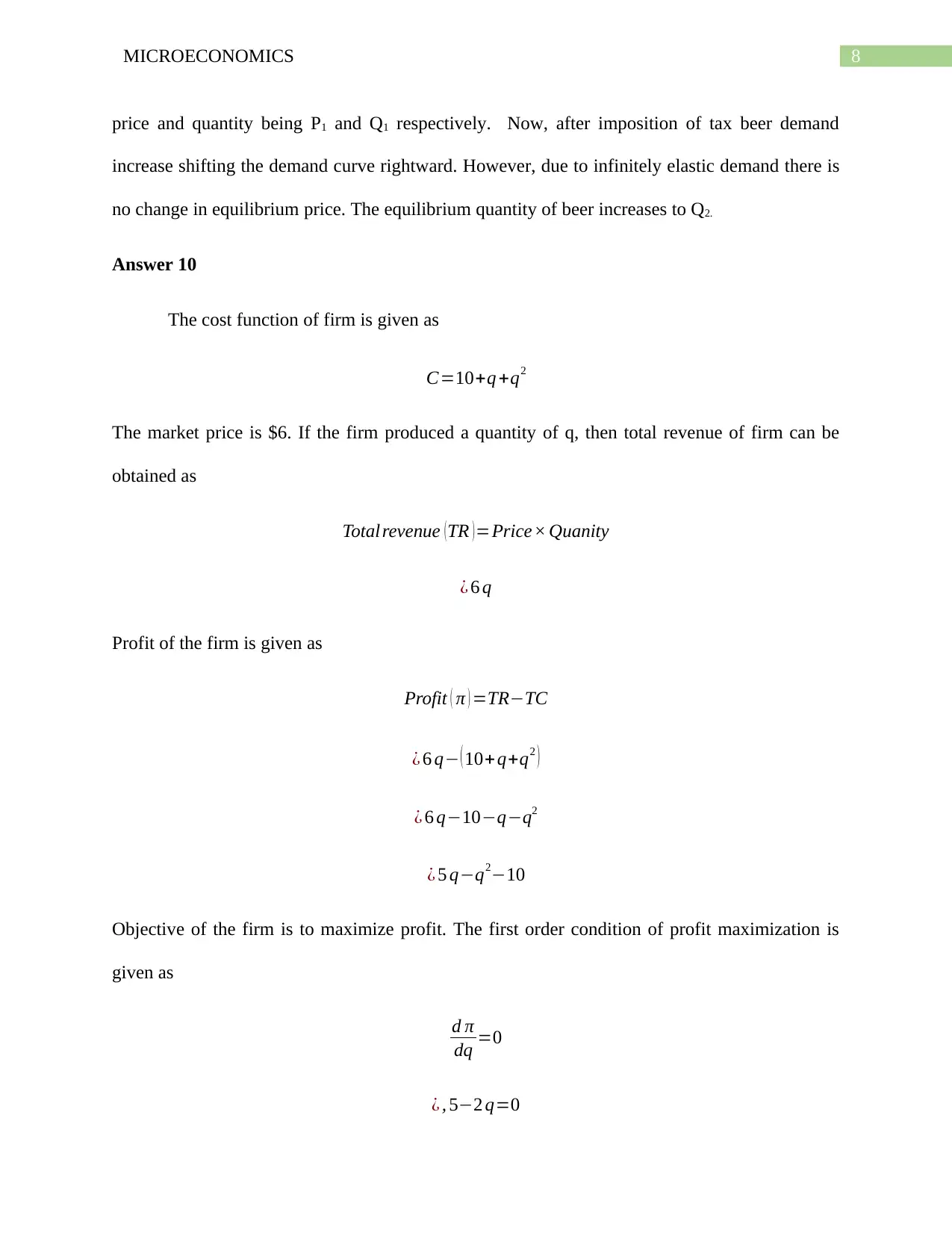
8MICROECONOMICS
price and quantity being P1 and Q1 respectively. Now, after imposition of tax beer demand
increase shifting the demand curve rightward. However, due to infinitely elastic demand there is
no change in equilibrium price. The equilibrium quantity of beer increases to Q2.
Answer 10
The cost function of firm is given as
C=10+q +q2
The market price is $6. If the firm produced a quantity of q, then total revenue of firm can be
obtained as
Total revenue (TR )=Price× Quanity
¿ 6 q
Profit of the firm is given as
Profit ( π ) =TR−TC
¿ 6 q− ( 10+q+q2 )
¿ 6 q−10−q−q2
¿ 5 q−q2−10
Objective of the firm is to maximize profit. The first order condition of profit maximization is
given as
d π
dq =0
¿ , 5−2 q=0
price and quantity being P1 and Q1 respectively. Now, after imposition of tax beer demand
increase shifting the demand curve rightward. However, due to infinitely elastic demand there is
no change in equilibrium price. The equilibrium quantity of beer increases to Q2.
Answer 10
The cost function of firm is given as
C=10+q +q2
The market price is $6. If the firm produced a quantity of q, then total revenue of firm can be
obtained as
Total revenue (TR )=Price× Quanity
¿ 6 q
Profit of the firm is given as
Profit ( π ) =TR−TC
¿ 6 q− ( 10+q+q2 )
¿ 6 q−10−q−q2
¿ 5 q−q2−10
Objective of the firm is to maximize profit. The first order condition of profit maximization is
given as
d π
dq =0
¿ , 5−2 q=0
⊘ This is a preview!⊘
Do you want full access?
Subscribe today to unlock all pages.

Trusted by 1+ million students worldwide
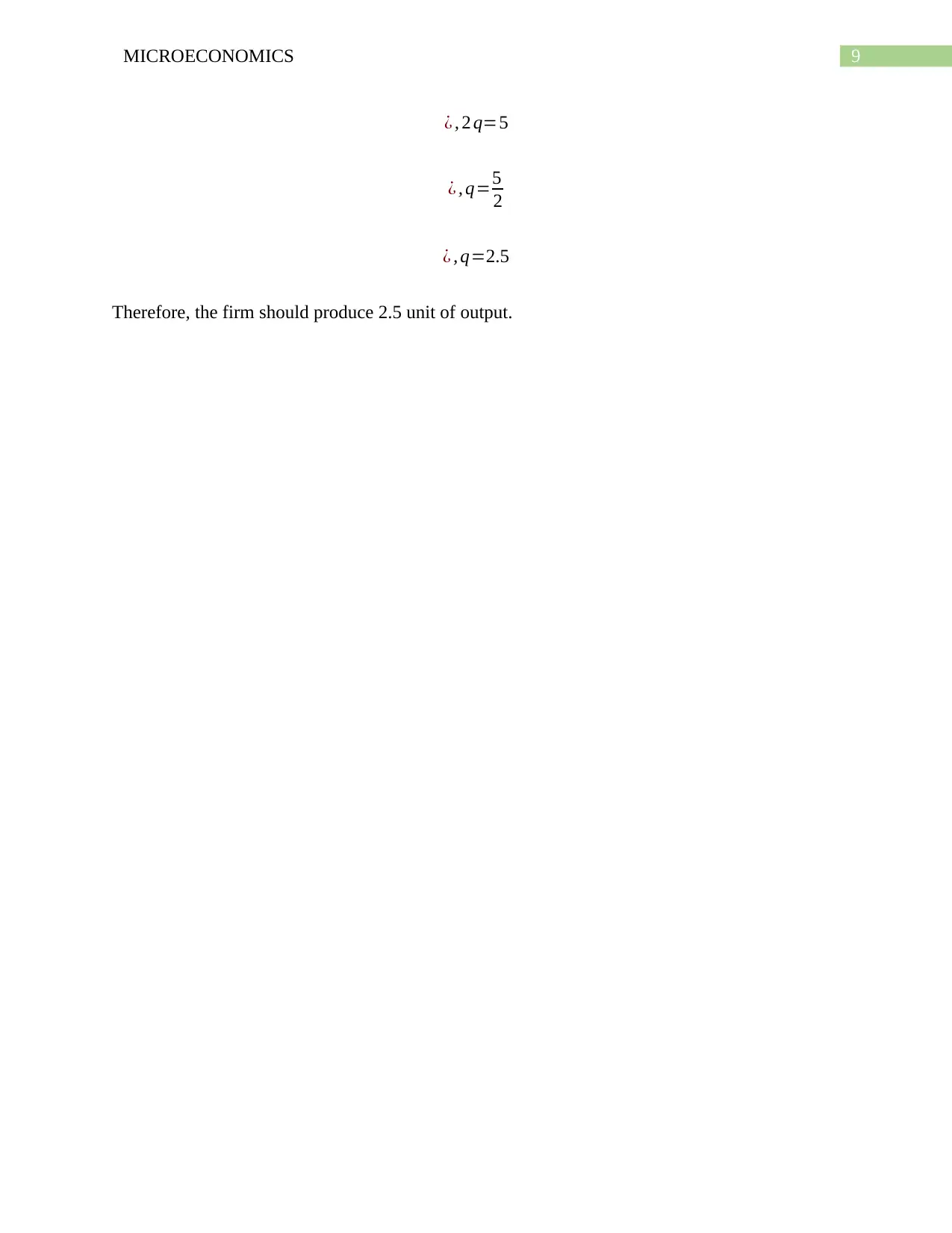
9MICROECONOMICS
¿ , 2 q=5
¿ , q=5
2
¿ , q=2.5
Therefore, the firm should produce 2.5 unit of output.
¿ , 2 q=5
¿ , q=5
2
¿ , q=2.5
Therefore, the firm should produce 2.5 unit of output.
Paraphrase This Document
Need a fresh take? Get an instant paraphrase of this document with our AI Paraphraser
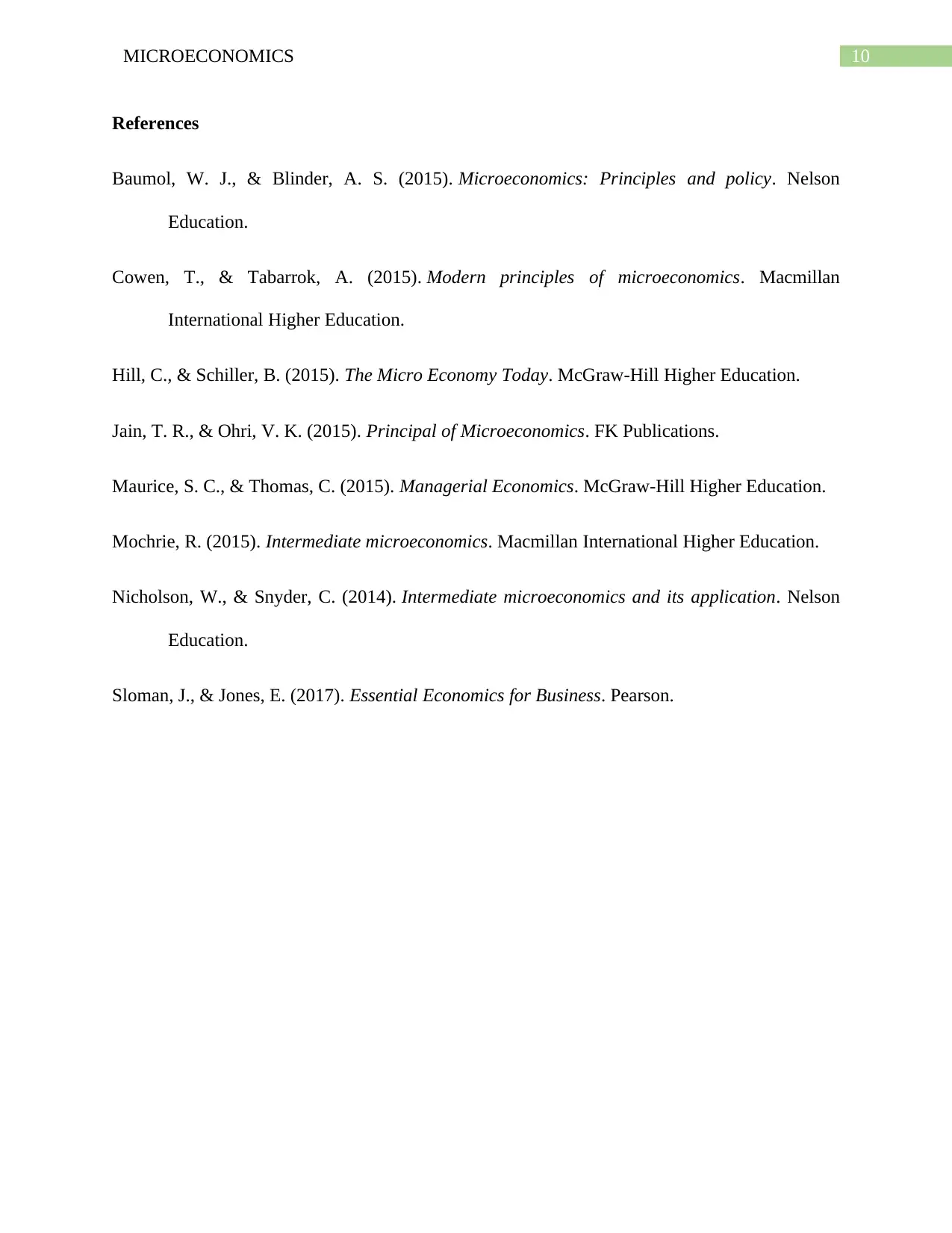
10MICROECONOMICS
References
Baumol, W. J., & Blinder, A. S. (2015). Microeconomics: Principles and policy. Nelson
Education.
Cowen, T., & Tabarrok, A. (2015). Modern principles of microeconomics. Macmillan
International Higher Education.
Hill, C., & Schiller, B. (2015). The Micro Economy Today. McGraw-Hill Higher Education.
Jain, T. R., & Ohri, V. K. (2015). Principal of Microeconomics. FK Publications.
Maurice, S. C., & Thomas, C. (2015). Managerial Economics. McGraw-Hill Higher Education.
Mochrie, R. (2015). Intermediate microeconomics. Macmillan International Higher Education.
Nicholson, W., & Snyder, C. (2014). Intermediate microeconomics and its application. Nelson
Education.
Sloman, J., & Jones, E. (2017). Essential Economics for Business. Pearson.
References
Baumol, W. J., & Blinder, A. S. (2015). Microeconomics: Principles and policy. Nelson
Education.
Cowen, T., & Tabarrok, A. (2015). Modern principles of microeconomics. Macmillan
International Higher Education.
Hill, C., & Schiller, B. (2015). The Micro Economy Today. McGraw-Hill Higher Education.
Jain, T. R., & Ohri, V. K. (2015). Principal of Microeconomics. FK Publications.
Maurice, S. C., & Thomas, C. (2015). Managerial Economics. McGraw-Hill Higher Education.
Mochrie, R. (2015). Intermediate microeconomics. Macmillan International Higher Education.
Nicholson, W., & Snyder, C. (2014). Intermediate microeconomics and its application. Nelson
Education.
Sloman, J., & Jones, E. (2017). Essential Economics for Business. Pearson.
1 out of 11
Related Documents
Your All-in-One AI-Powered Toolkit for Academic Success.
+13062052269
info@desklib.com
Available 24*7 on WhatsApp / Email
![[object Object]](/_next/static/media/star-bottom.7253800d.svg)
Unlock your academic potential
Copyright © 2020–2025 A2Z Services. All Rights Reserved. Developed and managed by ZUCOL.





